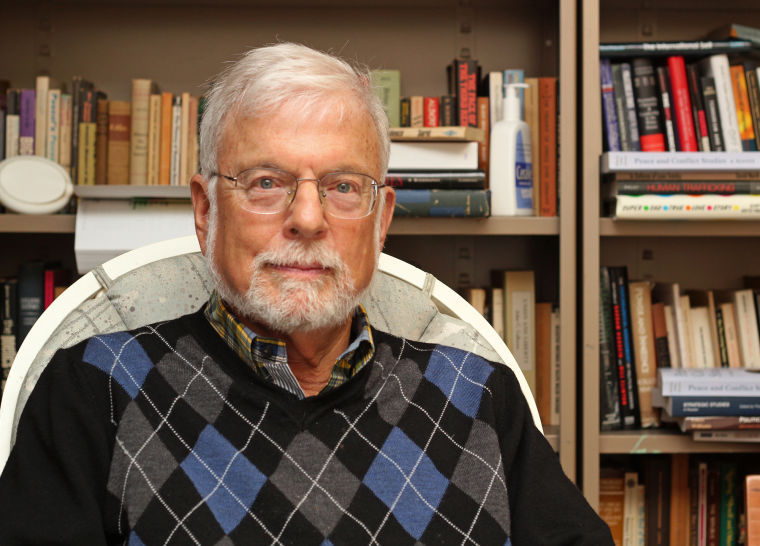
James Glass, a political philosophy professor, has been teaching a government and politics course that has examined political topics through film for nearly 30 years.
Movies old and new line the shelves of James Glass’ office — they have been a part of his life for as long as he can remember.
Glass remembers hanging out as a child in Los Angeles at the Gordon Theater all day with his father, who was the manager. Now, as a political philosophy professor, Glass has channeled his love for movies into the classroom with a summer course that looks at a political topic through a cinematic lens.
The summer course — now called GVPT 388A: Film and the Study of Politics of Terror in the Family and the State— began in 1972 as one of the first three-week summer courses this university offered, and, much to Glass’ surprise, it quickly gained popularity. While the course’s focus has evolved over the years from social discontent to terror, it still draws a wait-list.
“I’d long been interested in film. The idea was to create a unique educational experience,” Glass said. “I never thought it would get this popular.”
Students flocked to the class, and at its peak in the ’80s, more than 150 students were enrolled. Glass was forced to move to Hoff Theater to accommodate the students.
The material, not the professor, is what draws the students into the class, he said.
However, some of Glass’ students would disagree with that statement — it’s Glass who brings the material to life, said Yael Nagar, a sophomore government and politics major in Glass’ introduction to political theory class. Glass brings interesting perspectives into his classes, she said.
“He has all these opinions about human nature and society and how the world is constructed,” Nagar said. “It’s really interesting to unravel where he gets those ideas.”
Junior government and politics major Matt Lustbader said Glass’ experiences liven up his classroom lectures.
“Professor Glass is a really knowledgeable guy,” he said. “His contribution to the class is really valuable.”
When he began the summer course, Glass used film to teach politics of the family. But as time wore on, he said, students could no longer relate to the family conflicts of the ’70s and ’80s. About four or five years ago, he decided it was time to switch the theme of the course to something more timely. Glass selected terror and terrorism because in a post-9/11 world, it seemed like a relevant topic.
Every week, students watch four movies centered on three different themes.
During week one, the focus is terror in and on the self; week two focuses on terror in the community, and week three is centered on state-sponsored terror. Glass mixes popular films such as Black Swan and Shutter Island with lesser-known films such as City of God and The Grey Zone.
Glass said the films force students to think about the nature of terror and how it contributes to political violence.
“Students see terror not so much as a set of policy questions — how to prevent terrorism, how to contain it and so on — but they see terror enacted [in the movies],” Glass said. “They get a sense of the power of ideology, the power of political belief, that drives individuals to really hurt people.”
An online section of the course has been added, but Glass feels this takes away from the overall experience. He enjoys the community the students build with one other over the three-week period.
“Friendships have developed, we’ve had situations where students have met in the film course,” Glass said. “That has been one of my favorite things.”
Terrorism will likely remain the theme of the course for the foreseeable future — at least until it is no longer a part of the national conversation, Glass said. It has become a large part of Americans’ lives, and he believes it is here to stay.
“When it happens here, when it happens in Boston, it becomes more of a collective psychological phenomenon that affects everybody,” Glass said. “Watching these two guys being pursued by Boston Police, it was like a movie. It couldn’t have been more dramatic and terrifying at the same time.”



